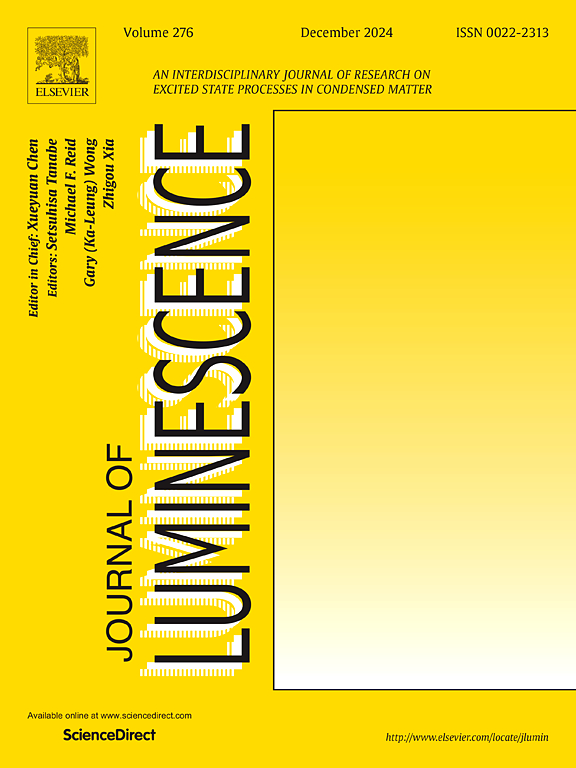利用苯乙基碘化铵增强无铅Cs3Cu2I5薄膜的光学特性
IF 3.6
3区 物理与天体物理
Q2 OPTICS
引用次数: 0
摘要
无铅铜基卤化物钙钛矿,特别是Cs3Cu2I5,由于其优异的光电性能,代表了有毒铅基材料的有希望的替代品。然而,它们的实际应用受到诸如需要严格的惰性气氛处理和存在固有缺陷等挑战的限制。本研究探讨了苯乙基碘化铵(PEAI)改善Cs3Cu2I5薄膜结构和形态特征的能力,目的是提高其光学性能。采用可控环境处理方法,将不同浓度的PEAI掺入前驱体溶液中。结果表明,加入1 mg PEAI后,晶体结晶度明显提高,晶格应变降低,光致发光量子产率(PLQY)由68.8%提高到81.8%,相对于对照提高了13%。此外,peai处理的薄膜表现出优异的稳定性,在环境储存60天后保持81.5%的PLQY。这些发现突出了PEAI作为优化铜基卤化物钙钛矿的高效添加剂,为开发用于光学应用的高效、稳定、无铅发射器提供了一条直接的途径。本文章由计算机程序翻译,如有差异,请以英文原文为准。
Enhancing the optical characteristics of lead-free Cs3Cu2I5 films via phenethylammonium iodide
Lead-free copper-based halide perovskites, especially Cs3Cu2I5, represent promising alternatives to toxic lead-based materials because of their excellent optoelectronic properties. However, their practical application is limited by challenges such as the need for strict inert-atmosphere processing and the presence of intrinsic defects. In this study, the ability of phenethylammonium iodide (PEAI) to improve the structural and morphological characteristics of Cs3Cu2I5 films was explored, with the goal of enhancing their optical performance. A controlled ambient processing method was employed, in which PEAI at various concentrations was incorporated into the precursor solution. The results show that adding 1 mg of PEAI significantly improved the crystallinity, reduced the lattice strain, and increased the photoluminescence quantum yield (PLQY) from 68.8 % to 81.8 %, which corresponds to an absolute increase of 13 % compared with the control. Additionally, PEAI-treated films exhibit excellent stability, maintaining a PLQY of 81.5 % after 60 days of ambient storage. These findings highlight PEAI as a highly effective additive for optimizing copper-based halide perovskites, offering a straightforward path toward the development of efficient, stable, lead-free emitters for optical applications.
求助全文
通过发布文献求助,成功后即可免费获取论文全文。
去求助
来源期刊

Journal of Luminescence
物理-光学
CiteScore
6.70
自引率
13.90%
发文量
850
审稿时长
3.8 months
期刊介绍:
The purpose of the Journal of Luminescence is to provide a means of communication between scientists in different disciplines who share a common interest in the electronic excited states of molecular, ionic and covalent systems, whether crystalline, amorphous, or liquid.
We invite original papers and reviews on such subjects as: exciton and polariton dynamics, dynamics of localized excited states, energy and charge transport in ordered and disordered systems, radiative and non-radiative recombination, relaxation processes, vibronic interactions in electronic excited states, photochemistry in condensed systems, excited state resonance, double resonance, spin dynamics, selective excitation spectroscopy, hole burning, coherent processes in excited states, (e.g. coherent optical transients, photon echoes, transient gratings), multiphoton processes, optical bistability, photochromism, and new techniques for the study of excited states. This list is not intended to be exhaustive. Papers in the traditional areas of optical spectroscopy (absorption, MCD, luminescence, Raman scattering) are welcome. Papers on applications (phosphors, scintillators, electro- and cathodo-luminescence, radiography, bioimaging, solar energy, energy conversion, etc.) are also welcome if they present results of scientific, rather than only technological interest. However, papers containing purely theoretical results, not related to phenomena in the excited states, as well as papers using luminescence spectroscopy to perform routine analytical chemistry or biochemistry procedures, are outside the scope of the journal. Some exceptions will be possible at the discretion of the editors.
 求助内容:
求助内容: 应助结果提醒方式:
应助结果提醒方式:


